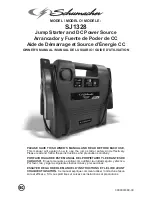
•
7
•
5.6 CHARGING THE INTERNAL BATTERY
WHILE DRIVING
You may also charge the internal battery
while driving, using a male-to-male
charger cable (part number 94500109 –
not included).
IMPORTANT:
DO NOT CHARGE
INTERNAL BATTERY FOR MORE THAN
30 MINUTES OR LEAVE THE BATTERY
UNATTENDED. IT COULD EXPLODE,
CAUSING PROPERTY DAMAGE OR
PERSONAL INJURY.
1.
Make sure the car is running.
2.
Insert one end of the accessory cable
into the 12V DC power outlet.
3.
Insert the other end of the accessory
cable into the vehicle’s accessory
outlet (lighter socket).
NOTE:
The red
and green
LEDs
do not operate during this method of
charging. Using this method to charge the
battery overrides the maintain mode and
the battery can be overcharged.
4.
Monitor the progress of the charge by
pressing the
Battery Status
button on
the front of the unit. When the battery is
fully charged, disconnect the accessory
cable from the jump starter, then from
the lighter socket of the vehicle.
NOTE:
Completely disconnect the charger
cable when the engine is not running.
6. OPERATING INSTRUCTIONS
6.1 JUMP STARTING A VEHICLE ENGINE
WARNING! A SPARK NEAR THE
BATTERY MAY CAUSE A BATTERY
EXPLOSION. TO REDUCE THE RISK
OF A SPARK NEAR THE BATTERY:
IMPORTANT:
Using the Engine Start
feature without a battery installed in the
vehicle will damage the vehicle’s electrical
system.
IMPORTANT:
Do not use the jump starter
while charging the internal battery.
1.
Turn the vehicle’s ignition OFF before
making cable connections.
2.
Position the DC cables to reduce the
risk of damage by the hood, door and
moving or hot engine parts.
NOTE:
If it is necessary to close the
hood during the jump starting process,
ensure that the hood does not touch
the battery clips or cut the insulation of
the cables.
3.
Stay clear of fan blades, belts, pulleys
and other parts that can cause injury.
4.
Check the polarity of the battery posts.
The POSITIVE (POS, P, +) battery post
usually has a larger diameter than the
NEGATIVE (NEG, N, -) post.
5.
Determine which post of the battery is
grounded (connected) to the chassis.
If the negative post is grounded to the
chassis (as in most vehicles), see step
6. If the positive post is grounded to
the chassis, see step 7.
6.
For a negative-grounded vehicle,
connect the POSITIVE (RED) clip from
the jump starter to the POSITIVE (POS,
P, +) ungrounded post of the battery.
Connect the NEGATIVE (BLACK) clip
to the vehicle chassis or engine block
away from the battery. Do not connect
the clip to the carburetor, fuel lines or
sheet-metal body parts. Connect to a
heavy gauge metal part of the frame or
engine block.
7.
For a positive-grounded vehicle,
connect the NEGATIVE (BLACK) clip
from the jump starter to the NEGATIVE
(NEG, N, -) ungrounded post of the
battery. Connect the POSITIVE (RED)
clip to the vehicle chassis or engine
block away from the battery. Do not
connect the clip to the carburetor,
fuel lines or sheet-metal body parts.
Connect to a heavy gauge metal part of
the frame or engine block.
8.
Crank the engine. If the engine does not
start within 5-8 seconds, stop cranking
and wait at least 1 minute before
attempting to start the vehicle again.
(This permits the battery to cool down.)
9.
After the engine starts, disconnect the
black clamp (-) and then the red clamp,
(+) in that order.
10.
Recharge the jump starter as soon
as possible after use.
6.2 POWERING A 12V DC DEVICE
The jump starter is a power source for
all 12V DC accessories that are equipped
with a 12V accessory plug. Use it for
power outages and on fishing or camping
trips. Estimated usage times are listed in
the following chart.
NOTE:
Do not power a 12V device
with the jump starter while charging the
internal battery.
1.
Make sure the device to be powered
is OFF before inserting the 12V DC
accessory plug into the 12V DC
accessory outlet.
2.
Ensure the battery clamps are secured
on the storage holders.






















